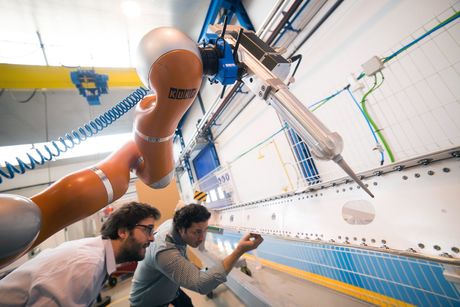Mobile robots for the aerospace industry
Wednesday, 02 March, 2016

The aerospace industry is showing how the factory of the future may be done. In the VALERI project, European researchers and industry partners have demonstrated that mobile manipulators — mobile industrial robots — are fully able to work side by side with human colleagues. The robots in this project are applying sealant to aircraft fuselages and inspecting aircraft parts.
Coordinated by the Fraunhofer Institute for Factory Operation and Automation IFF in Magdeburg, experts specifically aimed to automate manufacturing jobs that can be hazardous to health or are extremely monotonous and physically strenuous. They also want to have jobs with many steps that recur throughout the aircraft manufacturing process performed by one single mobile robot in the future. Robots will not replace skilled labour — rather, they will simplify their work and assist them in their jobs.
Researchers in the VALERI project (Validation of Advanced, Collaborative Robotics for Industrial Applications) established the technical conditions for humans and robots to work next to each other. Taking the application of sealant to aircraft fuselages and the inspection of parts as model tasks, they demonstrated at Airbus DS facilities in Seville that protective barriers will no longer be needed in future manufacturing facilities.
Humans and robots can work right next to each other, maybe even on the same part, and still act autonomously. The project partners also added a second inspection sensor to the VALERI robot system to additionally demonstrate the flexibility of the system for use in other manufacturing industries. The experts are breaking new ground with VALERI, making their vision for human-robot collaboration and the aerospace industry reality and getting one step closer to Industry 4.0.
The industrial end users Airbus DS and FACC, the industrial robotics manufacturer KUKA Robotics GmbH, systems integrator IDPSA, and the research partners PROFACTOR GmbH and PRODINTEC were involved in the VALERI project. The project was funded by the European Commission with €3.6 million under the European Union Seventh Framework Programme (FP7) ‘Factories of the Future’.
More flexibility
Humans work on large parts in a stationary production cell in manufacturing. Over a period of days, several shifts of workers assemble and inspect the parts. Specialised, stationary robotic systems are not cost effective in such a manufacturing environment. This is expected to change in the future: a mobile robot will be performing similar tasks at several workstations. This is why the VALERI system needs to be more flexible than traditional, stationary industrial robots.
Complex challenges
The project focused on three model jobs: applying sealant along a groove, subsequently inspecting the sealant and inspecting braided carbon parts. While the first two applications are closely related, the VALERI consortium selected a third application to demonstrate the system’s overall flexibility. The robot is able to change tools, and programming it to execute entirely new operations is done quickly and intuitively.
Individual technologies, highly integrated system
At the outset of the project, KUKA modified an existing omniRob robot to have a reach suitable for the range of tasks planned. This included adding a rotatable linear axis atop the mobile platform, thus giving the robot 12 degrees of freedom and a reach comparable to that of a human. Such a hyper-redundant system necessitated coordinating all of its motions — real mobile manipulation — so that the VALERI robot could be programmed intuitively and could perform all of its tasks.
The researchers from the Fraunhofer IFF in Magdeburg developed tactile sensors and a camera-based workplace monitoring system as safety technologies for direct human-robot collaboration. The tactile sensors detect contact and the robot stops before biomechanical thresholds are reached. The researchers had determined the maximum allowable robot speeds beforehand. The data is extremely important for the global robotics community and will aid in the validation of collaborative robots with power- and force-limiting safeguards, with tactile sensors being used for haptic interaction with the robot. User studies have confirmed that haptic interaction, which essentially requires operators to give the robot a push in the direction in which it should move, is very intuitive to use.
The workplace monitoring system consists of a time-of-flight camera combined with three stereo camera pairs. It tracks a tool’s movement and creates a virtual safeguarded zone around it. The robot stops if a human or object enters this safeguarded zone, thus preventing any collision.
The experts from IDPSA developed the tool that applies sealant and integrated it in the robot controller, thus making it possible to closely coordinate the application of sealant with the robot’s speed and orientation. Sealant is now applied along curved and flat trajectories significantly better.
The research organisation Prodintec adapted and integrated a camera-based tool that localises parts. The camera captures 3D point clouds and uses CAD matching software to identify and localise parts. This enables VALERI to locate and work on parts, which are sometimes on rollers and not always in the same spot in the factory. Profactor also developed and integrated two other tools, which the VALERI robot can use to inspect the applied sealant and braided carbon parts.
Australia must rethink the foundations of industrial automation
In order to compete globally, we need a willingness to rethink the foundations and build...
IMARC 2025 turns up the innovation spotlight
IMARC 2025 will bring mine owners, operators and contractors together with a line-up of the...
Skills are more critical than ever in today’s AI world
Our increasing reliance on AI to offload cognitive tasks weakens our memorising systems and skills.











